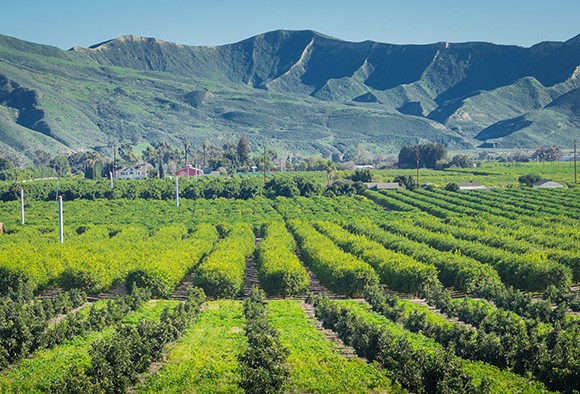Pushing the boundaries: Santa Paula to decide on development
IN THIS ARTICLE
- Agribusiness Topic
- Marissa Wenzke Author
By Marissa Wenzke Friday, February 13th, 2015

Santa Paula-based Limoneira Co. has already invested $54 million in East Area One, a project that would include 500 acres in Santa Paula. (Nik Blaskovich / Business Times photo)
After more than a decade of planning and $54 million in investment, Limoneira’s 500-acre, multi-phase development project, East Area One, could receive final approval for beginning development at a Santa Paula City Council meeting on Feb. 17.
The council will decide whether to enter into an official development agreement with Limoneira for East Area One, in addition to granting approval for a supplemental environmental impact report and full traffic study for the project.
“If we get approval next week, we’re ready to start the development,” Limoneira CEO Harold Edwards said. “The project is fully entitled at that point, after 11 years and $54 million in investment.”
The 500-acre project would include about 1,500 residential housing units and set aside about 20 acres of land for public institutions such as a fire station, police substation and schools. More than 225 acres would be set aside as open space, for uses including agricultural preserve, open space preserve and public parks and fields. Meanwhile, just 215,000 square feet would be set aside for commercial use and 25,000 square feet for light industrial use.
According to Edwards, Limoneira plans to commit at least another $200 million to laying down the groundwork for bare infrastructure such as roads over the next year.
Mike Penrod, project manager for East Area One, said the company plans to identify a development partner within 60 to 90 days of the city council’s approval, if granted, and the development expects to have homes fully built and ready for occupation by the end of 2016.
The Santa Paula city council was originally set to decide on a development agreement with Limoneira in December, but the agriculture company requested that the meeting be pushed back so newly elected city councilmembers have enough time to review the project.
“We wanted to make sure the three new city councilmembers had enough time to read through and consider the project and didn’t have to hurry,” Penrod said.
With years of planning behind it, East Area One has undergone a series of changes through public meetings since its development plans were first completed in February 2008.
“It goes back to 2004, when we formed a letter of cooperation with the city of Santa Paula to create a specific plan for development,” Edwards said.
In 2006, the company sought input from the community through a series of open meetings with property owners, nearby residents, city officials and other public agencies. While the city council and planning commission were supportive of signing a development agreement with Limoneira that year, a law requiring public permission to rezone agricultural land for commercial-use delayed the project a few years, according to Edwards.
In 2008, voters approved the project’s development with the passage of Measure G, which received 82 percent of the vote. Then came one of the worst real estate downturns in decades.
Another obstacle for the project came when the Ventura Local Agency Formation Commission, or LAFCo, expressed concerns that East Area One would make up a peninsula of land, which is prohibited by the commission. The city of Fillmore, city of Santa Paula and Limoneira worked from 2008 to 2011, Edwards said, to develop an ordinance that would allow for annexing a portion of unincorporated area known as East Area Two to the city of Santa Paula. East Area Two consists of several dozen acres along Highway 126.
This annexation affected some features of East Area One, according to Penrod, because it introduced another strip of commercial land to the area around Highway 126.
“Once East Area Two got annexed into the city, we didn’t need as much retail and commercial space in Ease Area One,” Penrod said.
This increased the amount of open space in East Area One by about 20 acres, he said. LAFCo later gave its approval for the project to move forward in 2012, after the annexation was complete.
Following this decision, Limoneira made other adjustments to the East Area One plans to accommodate for market-related concerns, according to Edwards.
“Once that was approved, Limoneira wanted to work with different developers who knew the market,” he told the Business Times. “The market was very different from when we first created the specific plan in 2006.”









